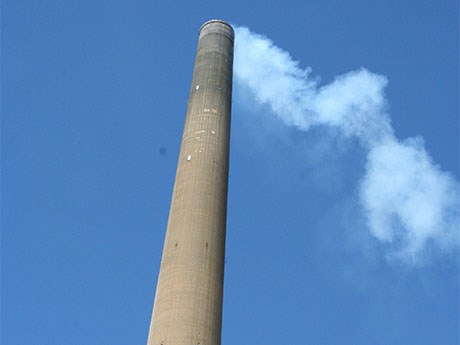With sulphur dioxide emissions from Vale’s operations in Sudbury down from two million tonnes a year in the 1970s to the current level of between 130,000 and 150,000 tonnes, most people would jump to the conclusion that SO2 is no longer much of a problem.
Not so, according to Frank Javor, manager of environment air for the company’s Sudbury operations.
The Inco, now Vale Superstack was built to work with the production environment of the 70s, said Javor.
“There were five or six reverberatory furnaces, each one with six roasters and all that stuff went up the stack. Everything worked by natural draft and the emissions were dispersed far and wide.”
As the company diverted increasing volumes of SO2 for conversion to sulphuric acid, the volume of material going up the stack decreased.
“With less energy in the stack, we don’t get the same dispersion for the remaining SO2,” explained Javor. To help compensate for the loss, “we have four humongous heaters burning natural gas at the base of the stack and two giant fans pushing gas up.”
Weather
Wind patterns, temperature and other atmospheric conditions have a huge impact on dispersion and the company’s compliance with government standards for ground level SO2 concentrations. If the weather patterns are such that the plume is simply going to descend on Sudbury, smelter operations are scaled back or shut down completely.
To remain in compliance with government limits on SO2, Vale’s Emission Reduction Program relies on one of the most sophisticated meteorological operations in the country.
From his air-conditioned office in the otherwise sweltering smelter complex, meteorologist Robert Bedard is surrounded by instrumentation, computer screens and camera monitors conveying real-time information about wind speeds, ground level SO2 concentrations and plume behaviour.
Weather monitoring is a two-step process, explained Javor. The first part is predictive.
“Robert comes in every morning and checks all the weather data on the Internet. He looks at Environment Canada data, gets an analysis of high level wind direction and temperature and forecasts what’s going to happen meteorologically.”
If necessary, smelter output is proactively scaled down.
“But because we’re not always right, we also have a real-time part of the program with monitoring throughout the community,” said Javor.
Monitoring
An air quality monitoring network of 18 stations jointly owned by Vale and Xstrata conveys real-time data on ground concentrations of SO2 to Bedard every five minutes. There’s also a mobile monitoring unit that records SO2 concentrations in other areas of the city.
Members of the public who have a concern about the air quality can call a smelter emission air quality complaints line. To investigate a complaint, Bedard sends the mobile unit out to the location to do a scan.
In addition to the 18 ground level air monitoring stations and the mobile unit, Vale gets data from several meteorological towers, which measure wind direction, speed, temperature, solar radiation and barometric pressure.
Javor’s team also makes use of sophisticated radio acoustic sounding (RAS) and sonic detection and ranging (SODAR) technology, which sends a pulse of sound up into the atmosphere to measure wind speed at 50 metre increments to a height of approximately 800 metres.
Data on wind speeds at higher elevations is necessary because “if you look at the nickel refinery stack and the Superstack on some days, you can see the plumes going in opposite directions,” said Javor. This is because the nickel refinery stack is 600 feet (183 metres) high, while the Superstack tops out at 1,200 feet as the world’s second tallest free standing chimney.
According to Javor, Vale scales back smelter production approximately 200 days a year. The worst days are hot, sunny days in the summer, when the sun heats the ground, causing the heated air to rise and interact with the plume.
Transition seasons in the spring and fall can also pose a problem and days without any wind at all are the worst.
“Even windy days, which you’d think would be great for dispersion, can be a problem if you have high winds that shear off part of the plume and cause it to come to ground,” noted Javor.
Once Vale’s Clean AER project is completed, SO2 emissions will fall to 20,000 tonnes from the current 130,000 to 150,000 tonnes per year, but there will still be a need for monitoring the weather and remaining in compliance with SO2 concentration limits.



